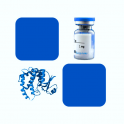
- Remove this product from my favorite's list.
- Add this product to my list of favorites.
Products
Viewed products
Newsletter
 |  |  |  |  |  |

Background
CD40 is also known as TNFRSF5, Bp50, CDW40, MGC9013, TNFRSF5 and p50, is a member of the TNF receptor superfamily which are single transmembrane-spanning glycoproteins, and plays an essential role in mediating a broad variety of immune and inflammatory responses including T cell-dependent immunoglobulin class switching, memory B cell development, and germinal center formation. CD40 is a costimulatory protein found on antigen presenting cells and is required for their activation. The binding of CD154 (CD40L) on TH cells to CD40 activates antigen presenting cells and induces a variety of downstream effects. CD40 contains 4 cysteine-rich repeats in the extracellular domain, and is expressed in B cells, dendritic cells, macrophages, endothelial cells, and several tumor cell lines. The extracellular domain has the cysteinerich repeat regions, which are characteristic for many of the receptors of the TNF superfamily. Interaction of CD40 with its ligand, CD40L, leads to aggregation of CD40 molecules,which in turn interact with cytoplasmic components to initiate signaling pathways. Early studies on the CD40-CD40L system revealed its role in humoral immunity. Defects in CD40 result in hyper-IgM immunodeficiency type 3 (HIGM3), an autosomal recessive disorder characterized by an inability of B cells to undergo isotype switching, as well as an inability to mount an antibody-specific immune response, and a lack of germinal center formation.
Source
Recombinant Human CD40, Mouse IgG2a Fc Tag, low endotoxin (MALS verified) (CD0-H525a) is expressed from human 293 cells (HEK293). It contains AA Glu 21 - Arg 193 (Accession # P25942-1).
Predicted N-terminus: Glu 21
Molecular Characterization
This protein carries a mouse IgG2a Fc tag at the C-terminus.
The protein has a calculated MW of 46.1 kDa. The protein migrates as 58 kDa under reducing (R) condition (SDS-PAGE) due to glycosylation.
Endotoxin
Less than 0.1 EU per μg by the LAL method.
Purity
>95% as determined by SDS-PAGE.
>90% as determined by SEC-MALS.
Formulation
Lyophilized from 0.22 μm filtered solution in 50 mM Tris, 100 mM Glycine, 150 mM NaCl, pH7.5 with trehalose as protectant.
Reconstitution
Please see Certificate of Analysis for specific instructions.
For best performance, we strongly recommend you to follow the reconstitution protocol provided in the CoA.
Storage
For long term storage, the product should be stored at lyophilized state at -20°C or lower.
Please avoid repeated freeze-thaw cycles.
This product is stable after storage at:
-20°C to -70°C for 12 months in lyophilized state;
-70°C for 3 months under sterile conditions after reconstitution.
Bioactivity
Please refer to product data sheet.
(1) "The Influence of CD40/CD40L, MMP2/MMP9 on Uterine Artery Blood Flow and Their Expression in Recurrent Miscarriage"
Li, Ding, Ding et al
Altern Ther Health Med (2024)
(2) "Having the cake and eating it? Clofazimine boosts immunotherapy while limiting side effects"
Kraehenbuehl, Wolchok, Merghoub et al
Cancer Cell (2024)
(3) "Co-stimulators CD40-CD40L, a potential immune-therapy target for atherosclerosis: A review"
Tian, Wang, Wan et al
Medicine (Baltimore) (2024) 103 (14), e37718
Showing 1-3 of 16984 papers.
Follow us